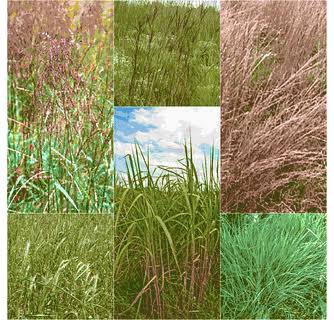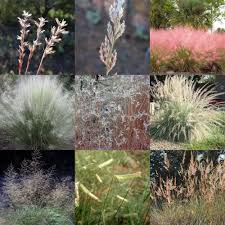Native Grasses are types of grass that naturally grow in a specific place without people planting them. These grasses have been there for a very long time, even before people built houses and cities. Native grasses are important because they help the environment in many ways.
First, native grasses have strong roots that go deep into the ground. These roots help prevent soil erosion, which is when the soil gets washed away by rain or blown away by the wind. Soil erosion can be a big problem because it can make the land less fertile and can even cause landslides. But when native grasses have strong roots, they hold the soil in place and keep it from moving.
Not only do native grasses keep the soil in place, but they also provide homes for many animals. Small insects, birds, and even mammals like rabbits find shelter and food in native grasses. These grasses create a habitat where animals can live and raise their babies. Some animals even eat the seeds of native grasses, which helps the grasses spread to new areas.
Another great thing about native grasses is that they don’t need a lot of water. They are used to the climate of their home, so they can survive with the amount of rain that falls naturally. This is important because in some places, there isn’t much water available for plants. Native grasses help conserve water and don’t put too much strain on the environment.
When people use native grasses in landscaping or gardening, it’s called “native landscaping” or “native gardening.” This is a good idea because native grasses are already adapted to the local conditions. They don’t need a lot of extra care or water, which makes them a low-maintenance choice. Plus, they look beautiful and add a natural touch to any area.
Some examples of native grasses include buffalo grass, switchgrass, and blue grama grass. These grasses are found in different parts of the world and have their own unique qualities. Buffalo grass, for instance, is known for its soft texture and ability to withstand droughts. Switchgrass is often used to make biofuels because it grows tall and has a lot of biomass. Blue grama grass has delicate seed heads that sway in the wind, adding grace to the landscape.
Native grasses are special types of grass that grow naturally in a place. They help prevent soil erosion, provide homes for animals, and are well-suited to their local environment. Using native grasses in landscaping is a good idea because they are low-maintenance and conserve water. So, by appreciating and planting native grasses, we can help the environment and create a beautiful, natural space.
Read Also: Products That Can Be Made From Cocoa
Types of Native Grasses

There are many different types of native grasses found around the world. Here are a few examples:
1. Buffalo Grass (Bouteloua dactyloides): Buffalo grass is a short, warm-season grass native to North America. It’s known for its fine texture, blue-green color, and ability to withstand drought conditions. It’s often used in lawns, parks, and golf courses.
2. Blue Grama Grass (Bouteloua gracilis): Blue grama grass is another species of Bouteloua native to North America. It’s a warm-season grass that forms tufts of fine leaves and distinctive seed heads that resemble eyelashes. It’s an important forage grass for grazing animals.
3. Switchgrass (Panicum virgatum): Switchgrass is a tall, warm-season grass native to North America. It’s known for its high biomass and adaptability to different soil types. It’s used for erosion control, wildlife habitat, and as a potential biofuel crop.
4. Fescue Grass (Festuca spp.): Fescue grasses are cool-season grasses that are native to various regions around the world. They are often used in lawns, pastures, and for soil stabilization. Tall fescue and fine fescue are common varieties.
5. Muhly Grass (Muhlenbergia spp.): Muhly grasses are native to North America and are admired for their feathery, colorful flower heads that sway in the wind. They’re often used as ornamental grasses in landscaping.
6. Indian Grass (Sorghastrum nutans): Indian grass is a tall, warm-season grass native to North America. It has distinctive golden flower heads and provides habitat for wildlife. It’s also used for prairie restoration.
7. Big Bluestem (Andropogon gerardii): Big bluestem is a tall, warm-season grass native to North America. It’s a dominant grass in prairies and is known for its bluish stems and three-parted seed heads.
8. Kangaroo Grass (Themeda triandra): Kangaroo grass is native to Australia and Southeast Asia. It’s an important grass for soil stabilization, and its seeds are a food source for various animals.
9. Quaking Grass (Briza spp.): Quaking grasses are known for their delicate, nodding flower heads that resemble rattles. They are native to various regions and are often used as ornamental grasses.
10. Prairie Dropseed (Sporobolus heterolepis): Prairie dropseed is a native grass in North America with fine-textured leaves and a pleasant fragrance. It’s used in natural landscaping and erosion control.
These are just a few examples of the many types of native grasses found across different regions. Each type has its own unique characteristics and benefits, contributing to the diversity and beauty of natural landscapes.
Read Also: Harvesting and Processing Of Cacao Fruits
Uses of Native Grasses

Native grasses have a wide range of uses that benefit both the environment and people. Here are some of their important uses:
1. Erosion Control: Native grasses have strong root systems that help prevent soil erosion. Their roots bind the soil together, making it harder for rain and wind to wash or blow the soil away. This is especially crucial in areas with steep slopes or areas prone to heavy rainfall.
2. Wildlife Habitat: Native grasses provide shelter, food, and breeding grounds for various wildlife species. Small mammals, birds, insects, and even larger animals can find refuge and sustenance in native grasslands.
3. Water Conservation: Many native grasses are well-adapted to the local climate and require less water compared to non-native grass species. Using native grasses in landscaping can help conserve water resources and reduce the need for irrigation.
4. Soil Improvement: As native grasses grow and die, their organic matter enriches the soil, improving its structure and fertility. This benefits not only the grasses themselves but also other plants that grow in the same area.
5. Carbon Sequestration: Native grasses, especially those with extensive root systems, can sequester carbon dioxide from the atmosphere. This helps mitigate climate change by reducing the amount of greenhouse gases in the air.
6. Restoration of Native Ecosystems: In areas where natural habitats have been disrupted by human activities, planting native grasses is a key step in restoring the original ecosystem. This is vital for preserving biodiversity and maintaining a healthy environment.
7. Livestock Forage: Some native grasses are valuable forage options for livestock. They provide nutritious food for grazing animals, contributing to sustainable livestock management.
8. Biofuel Production: Certain native grasses, like switchgrass, are being explored as potential biofuel crops due to their high biomass production and ability to grow in various conditions. This could offer a renewable energy source while using land that might not be suitable for food crops.
9. Cultural and Aesthetic Value: Native grasses hold cultural significance for many indigenous communities around the world. Additionally, their beauty and unique characteristics make them popular choices for landscaping, adding a natural and native touch to gardens, parks, and public spaces.
10. Educational Purposes: Native grasses can be used as educational tools to teach people about local ecosystems, plant biology, and environmental conservation. They provide opportunities for hands-on learning and raising awareness about the importance of native plants.
11. Natural Stormwater Management: Native grasses help absorb and slow down stormwater runoff, reducing the risk of flooding and soil erosion during heavy rains. This contributes to better water quality in rivers and streams.
12. Medicinal and Cultural Uses: Some native grasses have been used for traditional medicinal purposes by indigenous cultures. Learning about these uses can provide insights into the relationship between native plants and human health.
These diverse uses highlight the significant role that native grasses play in maintaining ecological balance, supporting biodiversity, and providing practical benefits for various aspects of human life.
Read Also: A Comprehensive Guide To Circular Economy Consulting





